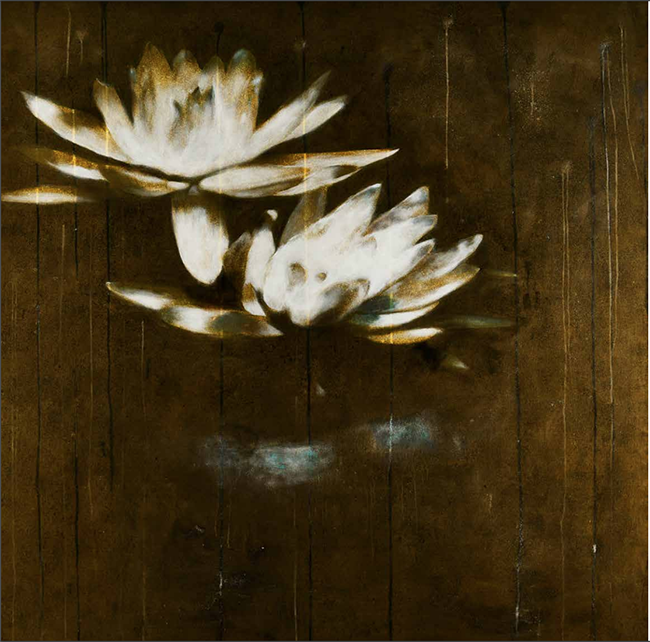Massimo Barlettani, born in Volterra in 1956, is a multifaceted Italian artist whose career spans several creative disciplines. From founding his own advertising agency, B&A, in 1989 to delving deeply into the world of art publishing, Barlettani’s professional trajectory has been as varied as it is successful. His exposure to a global network of photographers and artists has shaped his distinct artistic sensibility, ultimately guiding him toward his current path in the visual arts. In particular, his work explores the fragility of life, symbolized through delicate floral imagery and abstract reinterpretations of nature.

Barlettani’s career is not merely confined to the studio. His early years in advertising cultivated a sharp creative acumen, and he went on to win numerous awards for his innovative work. In addition, his time in art publishing proved instrumental, with Barlettani conceiving and publishing dozens of volumes under his own imprint, Zeta Scorpii Editore. This exposure to different mediums and perspectives, coupled with constant interaction with international artists, gave him a nuanced understanding of visual language.
While his career began with abstract painting, Barlettani’s work evolved over time into a more figurative exploration of iconic symbols, particularly focused on the female figure and natural forms. His art became less about static representation and more about dynamic, symbolic transformation—allowing the viewer to reconsider what is seen, and how it is perceived. Since 2012, he has further honed this exploration, concentrating on themes of life, death, and rebirth through symbolic depictions of flowers. These works, often rendered with rarefied delicacy, have become central to his artistic practice.
Barlettani’s 2021 piece Ninfee (Water Lilies) exemplifies the core themes of his artistic journey. Using acrylics and metallic pigments on canvas, the 150×150 cm work invites the viewer to ponder the transient beauty of life itself. What begins as a simple depiction of a flower soon evolves into a larger metaphor for existence, loss, and renewal.
In Ninfee, Barlettani zooms in on wildflowers, magnifying them to reveal their intricate architecture—details that many might overlook in everyday life. The flowers are not merely decorative; they are potent symbols of life’s cyclical nature. “They are not still lifes,” he states, “they are living lives.” The flowers in Barlettani’s work are alive, not cut off from the world of growth and reproduction, but instead presented at a moment of vibrancy, before they inevitably wither and return to the earth.
The artist’s approach to these flowers is layered with complexity. The use of metallic pigments creates a surface that shifts in appearance depending on the angle of the light. This iridescence is not just an aesthetic choice—it reflects Barlettani’s view that the beauty of life is elusive and ever-changing, just as the perception of the flowers changes with each passing moment. There’s an intention behind this: his work, like life itself, is fluid, unpredictable, and filled with an almost spiritual energy.
Barlettani’s use of abstract techniques, such as splashes, dripping, and blurring, serves to heighten the emotional intensity of his works. These elements create a sense of chaos and uncontrolled energy within the frame, as if the process of creation is shared with an unseen force. “It’s as if together with me there is something or someone who intervenes and makes everything amazing and spiritual,” he reflects. This interplay between control and surrender is key to understanding his artistic philosophy: his works are never static but are alive, evolving in their interaction with the viewer.
There’s a deeper layer to Barlettani’s floral representations. His flowers are not just beautiful still images—they are messages. They are signals from nature, speaking to the cycles of life, growth, and decay. They remind us of the interconnectedness of all living beings, much like the fragility of beauty itself. In his artwork, light and transparent butterflies flutter across the canvas, underscoring the theme of interconnectedness. They serve as a metaphor for the “butterfly effect” from chaos theory: the idea that the smallest of actions—a flap of wings—can reverberate far beyond its immediate surroundings.
In this way, Barlettani’s work is a study in paradox. It invites the viewer to see the invisible, to acknowledge the fleeting beauty that surrounds us, and to listen to the “noise” of nature—imperceptible yet undeniable. “The noise of flowers,” he says, “is a paradox that allows us to see what is beyond the figurative representation.” His paintings are not meant to be passive objects but active forces that continue to vibrate long after the viewer has walked away.
In a world increasingly overwhelmed by injustice and tragedy, Barlettani sees his work as a subtle form of resistance. By focusing on the delicate beauty of flowers—symbols of life’s fragility—he aims to spark hope. “Painting flowers is a revolutionary act,” he asserts. His art is not just about beauty for beauty’s sake but about celebrating the quiet, often overlooked miracles of existence. Each stroke of paint becomes a gesture of optimism, an invitation to pause and reflect on the small things that carry immense meaning.
Barlettani’s flowers speak to the resilience of life, how it always finds a way to reemerge, no matter the obstacles. His art serves as a reminder that even in the face of overwhelming darkness, there is light to be found—in the petals of a flower, the flap of a butterfly’s wings, or the vibrations of life itself.
Through his ongoing exploration of nature, symbolism, and abstraction, Massimo Barlettani invites us to not just see the world but to feel it, to embrace its impermanence, and to find beauty in every fleeting moment. In his hands, even the simplest of flowers becomes a powerful statement about the miraculous, fragile nature of existence.

